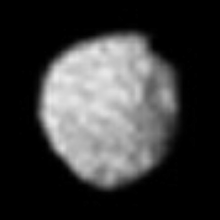Puck (moon)
Puck is a closer moon to Uranus. Puck was found from the images taken by Voyager 2 on December 30, 1985, and was given the designation S/1985 U 1.[6]
 | |
| Discovery | |
|---|---|
| Discovered by | Stephen P. Synnott / Voyager 2 |
| Discovery date | December 30, 1985 |
| Orbital characteristics | |
Mean orbit radius | 86,004.444 ± 0.064 km[1] |
| Eccentricity | 0.00012 ± 0.000061[1] |
| 0.76183287 ± 0.000000014 d[1] | |
| Inclination | 0.31921 ± 0.021° (to Uranus' equator)[1] |
| Satellite of | Uranus |
| Physical characteristics | |
Mean radius | 81 ± 2 km[2] |
| ~82,400 km²[3] | |
| Volume | ~2,225,000 km³[3] |
| Mass | ~2.9×1018 kg[3] |
Mean density | ~1.3 g/cm³ (assumed) |
| 0.028 m/s2[3] | |
| 0.069 km/s [3] | |
| synchronous[2] | |
| zero[2] | |
| Albedo | 0.11 ± 0.1 (at 0.55 μm)[4] |
| Temperature | ~64 K[3] |
| 20.2 [5] | |
In Celtic mythology and English folklore, Puck is a mischievous sprite, imagined as an evil demon by Christians; the moon is named after the Puck who appears in Shakespeare's A Midsummer Night's Dream, in which he travels around the globe at night with the fairies. It is also designated Uranus XV.[7]
Puck is the biggest of the small closer moons to Uranus. It is in the middle in size between Portia and Miranda, the smallest of the five bigger moons. Puck's orbit is also located between these two moons. Little is known about it aside from its orbit,[1] its radius about 81 km,[2] and its geometric albedo approximately 0.11.[4]
Of the moons found by the Voyager 2 imaging team, only Puck was found early enough that the probe could be programmed to take pictures of it in some detail. Images showed that Puck has a shape of a slightly prolate spheroid (ratio between axises is 0.97 ± 0.04).[2] Its surface is heavily cratered[8] and is grey in color.[2] There are three named craters on the surface of Puck. Observations with Hubble Space Telescope and large terrestrial telescopes found water ice absorption features in the spectrum of Puck.[4][9]
References
change- ↑ 1.0 1.1 1.2 1.3 1.4 Jacobson, R.A. (1998). "The Orbits of the Inner Uranian Satellites From Hubble Space Telescope and Voyager2 Observations". The Astronomical Journal. 115 (3): 1195–1199. Bibcode:1998AJ....115.1195J. doi:10.1086/300263. S2CID 118616209.
- ↑ 2.0 2.1 2.2 2.3 2.4 2.5 Karkoschka, Erich (2001). "Voyager's Eleventh Discovery of a Satellite of Uranus and Photometry and the First Size Measurements of Nine Satellites". Icarus. 151 (1): 69–77. Bibcode:2001Icar..151...69K. doi:10.1006/icar.2001.6597.
- ↑ 3.0 3.1 3.2 3.3 3.4 3.5 Calculated on the basis of other parameters
- ↑ 4.0 4.1 4.2 Karkoschka, Erich (2001). "Comprehensive Photometry of the Rings and 16 Satellites of Uranus with the Hubble Space Telescope". Icarus. 151 (1): 51–68. Bibcode:2001Icar..151...51K. doi:10.1006/icar.2001.6596.
- ↑ "Puck Statistics". Retrieved 2007-10-01.
- ↑ Smith, B.; Hansen, C. (January 16, 1986). "IAU Circular No. 4159". Retrieved 2006-08-06.
- ↑ "Planet and Satellite Names and Discoverers". Gazetteer of Planetary Nomenclature. USGS Astrogeology. July 21, 2006. Retrieved 2006-08-06.
- ↑ Thomas, P.; Veverka, J. and Johnson, T.V.; et al. (1987). "Voyager observations of 1985U1". Icarus. 72 (1): 79–83. Bibcode:1987Icar...72...79T. doi:10.1016/0019-1035(87)90121-7.
{{cite journal}}: CS1 maint: multiple names: authors list (link) - ↑ Dumas, Christophe; Smith, Bradford A. and Terrile, Richard J. (2003). "Hubble Space Telescope NICMOS Multiband Photometry of Proteus and Puck". Astronomical Journal. 126 (2): 1080–1085. Bibcode:2003AJ....126.1080D. doi:10.1086/375909. S2CID 122085744.
{{cite journal}}: CS1 maint: multiple names: authors list (link)
Other websites
change- Puck Profile Archived 2011-09-27 at the Wayback Machine by NASA's Solar System Exploration
- Page that includes a reprocessed version of the Voyager Puck image Archived 2007-10-04 at the Wayback Machine